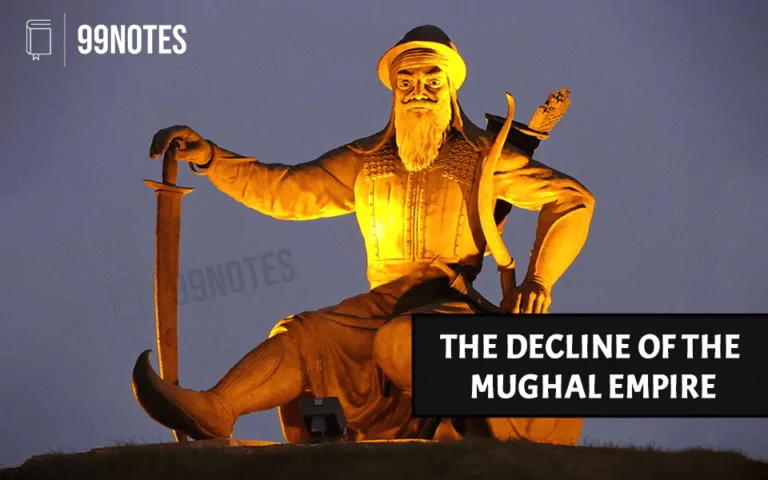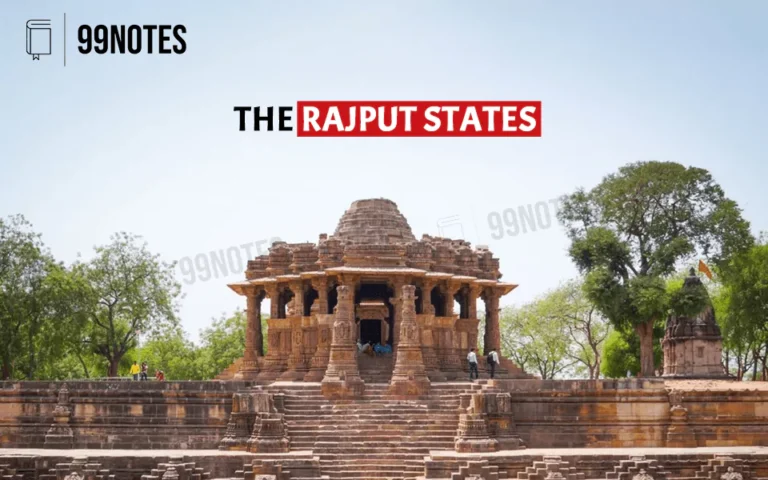Bhakti Movement: Origin, Main Principles, Causes, and its Effect [UPSC Medieval History Notes]
The Bhakti Movement in India
Introduction of Bhakti Movement
The Bhakti movement was a medieval religious reform movement that preached direct devotion to God without the mediation of a priest. It aimed to reform society by removing the boundaries of caste, creed and sex between the devotee(bhakta) and God (bhagwan).
Bhakti is rooted in the Sanskrit word “Bhaj“, meaning to serve. ‘Bhakti’ literally means fondness for, homage, faith or love, devotion, worship, and piety. The central theme of the Bhakti movement is that when devoted to God, a person must forget all distinctions and boundaries.
Main principles of Bhakti Movement
Main principles of the Bhakti movement are –
- God is one, but he can take many forms.
- Worshipping God with devotion is better than performing religious ceremonies and rituals and going on pilgrimages.
- Serving humanity is to worship God.
- All humans are equal, and all caste distinctions are meaningless.
- Superstitious practices are to be given up.
- Bhakti saints travelled to several places writing poems in vernacular languages, attracting many people under their fold.
The term ‘Bhakti’ itself originated in the Vedas for the first time and was extensively used in the Bhagwad-Gita by Vyasa. But the Bhakti movement as a socio-cultural phenomenon started much later in the 6th century CE.
The Bhakti movement first emerged in South India in the 6th to 10th century CE, mainly in the poems of Alvars and Nayanars. Later, it spread all over India, especially in North and East India, through the puranic literature such as Bhagavata-Purana and Bhagavad Gita. It reached its peak between the 14th and 17th centuries CE.
The Bhakti saints of South and East India are covered in this chapter. In the next chapter, we shall visit the religious developments in North India.
Causes of Bhakti Movement
- Religious factor – By the first millennium CE, religion grew to become highly ritualistic and superstitious, with many gods and conflicting ideologies. The Bhakti movement promoted a simple religion and a rational interpretation of religion based on love.
- Social factors – Indian society was plagued with many evils, such as the caste system, untouchability, atrocities against women, witchcraft and sacrifices. The religion earlier did not allow the untouchables or the women to perform sacrifices. However, the Bhakti religion was open to all.
- Political factors – Before the Turkish conquest, no heterodox belief could grow, as the society was dominated by the Rajput-Brahaman However, the advent of Islamic rulers deprived the Brahmans of their temple wealth and state protection. Thus, anti-Brahmanical and anti-caste ideologies could now challenge Brahmanical domination.
- Economic factors – With the growth of feudalism, oppressive revenue regimes based on regressive taxation and forced labour The bhakti movement represented the people against feudal oppression.
- Influence of Sufism –Bhakti and Sufism were based on the same ideas and emerged as a dissent against the orthodoxies in their respective religions.
- Solace in violent times – Masses suffered greatly under some fanatic rulers. There were instances of looting of temples and sacking of cities not only by the Western invaders but also by rulers within the country. Bhakti provided solace to the despairing hearts in the violent society.
Bhakti movement in South India![Bhakti Movement: Origin, Main Principles, Causes, And Its Effect [Upsc Medieval History Notes] | Updated July 26, 2024 Bhakti Saints Of South India- Bhakti Movement Upsc Notes](https://99notes.in/wp-content/uploads/2023/02/bhkti-saint-of-south-india-1024x851.jpg)
The Bhakti movement first started in South India. Two streams of Bhakti saints emerged in Tamil Nadu – Alvar (Vishnu Bhakt) and Nayanars (Shiva Bhakt), respectively.
Alvars and Nayanars were Tamil poet-saints who played an essential role in propagating the Bhakti Movement during the 5th – 10th centuries.
Features of Nayanars and Alvars
- They were highly critical of Buddhists and Jainas.
- They allowed all castes, including untouchables such as Pulaiyar and Panars.
- They drew upon ideas of love and heroism found in Sangam
- Preached love for Shiva (Nayanar) or Vishnu (Alvar) as a path to salvation. They connected with temple worship as these saint-poets visited Pandya/Chola temples.
- They recited poems praising the gods worshipped in local villages. They also composed Hagiographies (biographies of saints) of Alvars and Nayanars.
- Women saints emerged, too: We know of 63 Nayanar and 12 Alvar saints. Out of these, Andal was the only woman Alvar, and Karaikkal Ammaiyar, Mangayarkkarasiyar and Isaignaniyaar were women Nayanars.
Growth of Bhakti Literature in the South:
- Important books by Alvar Saints:
- Naalariya Divya Prabandham (Four Thousand Divine Hymns)
- It is composed of Poems written by 12 Alvar saints. Nathamuni compiled it in its present form between the 9th and 10th
- It sings the praises of Narayana (or Vishnu) and his many forms.
- It is considered as 5th Veda by Alvar Saints.
- Tiruvaymoli (words of the sacred mouth)
- It is an 1102-verse Tamil poem composed in the 9 th century by the Hindu poet-saint Nammalvar.
- It forms the third portion of the overall Divya Prabandham.
- Nammalvar identifies himself as a gopi who is looking for Krishna.
- Naalariya Divya Prabandham (Four Thousand Divine Hymns)
- Important books by Nayanar Saints:
- Thirumurai (holy division)
-
- It is a twelve-volume collection of hymns or songs praising Shiva, written by various Tamil poets.
- It is considered as 5th Veda by Shaivites.
- Thus, the Shaiva Siddhanta consists of 4 Vedas and Thirumurai.
-
- Thevaram
-
- It is a collection of the first seven volumes of Thirumurai.
- Nambiyandar Nambi compiled it.
- This collection contains the works of three Nayanar 7th and 8th century Tamil poets .they are Sambandar, Appar, and Sundarar.
-
- Periya Puranam
-
-
- It is included as the 12th part of Thirumurai and contains the life details of the 63 Nayanar saints.
- Sekkizhar compiled it
-
-
- Thirumurai (holy division)
The Development of Vedanta
- The Vedanta philosophy is one of the six orthodox philosophical systems of Hinduism. Others include Samkhya, Yoga, Nyaya, Vaisesika and Mimamsa.
- ‘Vedanta’ is derived from the term ‘Veda’ and ‘Anta’, which means the concluding portion of the Vedas.
- Vedantic schools emphasise knowledge, yoga, and devotion (bhakti yoga) to God.
Vedantic Bhakti Schools:
| Bhakti Saints | Philosophy and teachings |
Shankaracharya (8th century CE)![Bhakti Movement: Origin, Main Principles, Causes, And Its Effect [Upsc Medieval History Notes] | Updated July 26, 2024 Shankaracharya (8Th Century Ce) - Bhakti Movements In India](https://99notes.in/wp-content/uploads/2023/02/shankaracharya-230x300.jpg) |
· He was a devotee of Shiva.
Philosophy of Advait(Non-dualism) · The ultimate reality is the idea of the oneness of the Individual soul and Supreme God (Brahman). · Brahman is Nirguna, formless and without attributes. · The world around us is an illusion or Maya. · To understand Brahman’s true nature and find salvation, one must give up the world and follow the path of knowledge (Jnana yoga). |
Ramanujacharya (1017-1137)![Bhakti Movement: Origin, Main Principles, Causes, And Its Effect [Upsc Medieval History Notes] | Updated July 26, 2024 Statue Of Equality: Ramanujacharya (1017-1137)](https://99notes.in/wp-content/uploads/2023/02/ramanujacharya-240x300.jpg) |
· A devotee of Vishnu.
· Founder of Bhakti marg – a new stand of Bhakti developed in India. · He wrote Geeta Bhasya. · Worked for the upliftment of people with the spirit of equality Philosophy of Vishishta Advait (Qualified non-dual) · The idea of qualified oneness – soul, even when united with the supreme God remains distinct. |
Madhavacharya (1238–1317)![Bhakti Movement: Origin, Main Principles, Causes, And Its Effect [Upsc Medieval History Notes] | Updated July 26, 2024 Madhavacharya (1238–1317)- Bhakti Movements Upsc Notes](https://99notes.in/wp-content/uploads/2023/02/madhavacharya-253x300.jpg) |
Philosophy of Dvait (Dualism)
· We can reach God. But Bhakta and Bhagwan are different and can never be completely unified. · The world is not an illusion; it is real. · Propagated Tattvavada – the presence of two tattvas or categories of reality.
|
Vallabhacharya (1479-1531)![Bhakti Movement: Origin, Main Principles, Causes, And Its Effect [Upsc Medieval History Notes] | Updated July 26, 2024 Vallabhacharya (1479-1531)- Bhakti Movement Upsc Notes](https://99notes.in/wp-content/uploads/2023/02/vallabhacharya-248x300.jpg) |
Belonged to a Telugu Brahmin family residing in Varanasi.
Philosophy of Shuddha Advait (Pure Non-dualism) · God is the universe itself. Its size is like an atom. But it extends the whole body through its essence of intelligence. · The Maya is not unreal, and everything is Krishna’s Leela. · Vallabha founded Pushti Marg (path of grace). · He rejected asceticism and monastic life. The soul is both an enjoyer and a doer. |
Nimbaraka (11th century)![Bhakti Movement: Origin, Main Principles, Causes, And Its Effect [Upsc Medieval History Notes] | Updated July 26, 2024 Nimbaraka (11Th Century)- Bhakti Movement Upsc Notes](https://99notes.in/wp-content/uploads/2023/02/nimbaraka-214x300.jpg) |
Philosophy of Dvait Advait (Dualistic monoism)
· Three categories of objects –
· For Ramanuja, Oneness is greater than Difference, but for Nimbaraka, Difference is as crucial as oneness. |
| Chaitanya Mahaprabhu
(1486-1534) Source: Wikipedia |
Philosophy of Achintya-bhed-abheda
· God is simultaneously one and different from the creation. · Founded Gaudiya Vaishnavism. · composed the Shiksha-shtakam (eight devotional prayers) · According to his followers, he is the combined avatar of Radha and Krishna. · He popularised the chanting of Hare Krishna Maha-mantra. |
Bhakti movement in Karnataka
Virashaivism and Lingayatism
- It arose as a reaction to the Tamil Bhakti It sought to rid Hindu society of its social ills, such as the vengeance of women and the exploitation of lower castes by upper castes.
- Virashaivism(Heroic Shaiva) have emerged from Shaivism, which centres around the worship of Lord Shiva. However, not much is known about Virashaivism until about the 12th century CE when Basavanna entered the scene.
- Origin of Lingayatism:
- Basavanna propounded the ideas and practice of Virashaivism as distinct from Shaivism and other religious systems.
- Since his time, Veerashaivism also came to be known as Lingayatism because the most important component of the belief was the Ishtalinga or simply Linga (phallic image of Shiva worn on the body).
- Since the 12th century, Veerashaivites have also been referred to as Lingayats because they all wore a Linga on their bodies.
The essential features of Lingayatism:
- It projected a society where all were considered equal. It propagates an anti-pollution ideology.
- Rejection of the worship of a multitude of Gods and Goddesses. It believes in anti-ritualism.
- Shasthala ashtavaranas (six phases through which a person realises enlightenment) and panchacharas (five codes of conduct to be followed by the devotee).
- The Trinity of Lingayatism consists of Basavanna(founder), Akka Mahadevi (most prominent woman poet) and Allama Prabhu(12th-century mystic-saint and Vachana poet).
- Vachana Sahitya is a literature of Lingayats. It is a form of rhythmic writing in Kannada that evolved in the 11th and 12th centuries as a part of the Sharana movement.
- Vachanas are written in a simple verse form known as Vachanas which can be easily memorised.
- Vachana poets are known as Vachanakara.
- The Sharana movement
- The main aim of the devotee was the realisation of God and, at the same time, addressing the issues faced by people in the real world.
- The movement produced more than 200 people who composed vachanas (couplets).
- Poets of vachanas came from all sections of society: boat rowers, barbers, tailors, fishermen, wood-cutters, hunters, etc.
- Madara Chennaiah, an 11th-century cobbler-saint (during Western Chalukyas), is regarded as the “father of Vachana poetry”.
Difference between Lingayats and Virashaivas
| Lingayats | Virashaivas | |
| Origin | 12th-century social reformers Basavanna’s sect. | They were born out of Shiva’s lingam, followers of the panch peeth. |
| Worship | Shiva as a formless entity. | Shiva in human form. |
| Belief | Basava’s Vachanas don’t believe in the caste system | The Vedas don’t strictly reject the caste system |
| Religious institution | Bans temples and icon worship | Has temples and priests. |
Trinity of Lingayatism
Basavanna
- spread social awareness through his Vachana
- Introduced a new institution called Anubhava Mantapa (or the “hall of spiritual experience”), which welcomed people from all socioeconomic backgrounds to discuss mundane and spiritual issues openly.
- Basavanna gave discourses denouncing various social practices such as caste hierarchy, astrology, the building of temples, magical practices etc.
Allama Prabhu
- 12th-century mystic-saint and Vachana
- Propagated the unitary consciousness of Self and Shiva.
Akka Mahadevi (1130–1160)
- Title Akka (elder sister) was given by other Lingayat saints, indicating her unique place in the spiritual discussions in the “Anubhava Mantapa”.
- She wrote 430 extant Vachanapoems and two short writings, Mantrogopya and
Nathpanthis, Siddhars and Yogis
The Nathpanthis, Siddhars, and Yogis were among the religious movements that emerged during the mediaeval era. Using straightforward, logical arguments, they criticised traditional religion’s rituals, other features, and social order.
Beliefs of Nathpanthis, Siddhars and Yogi
- They criticised the rituals, conventional religion and the social order.
- They promoted renunciation of the world.
- These groups became popular, especially among “low” castes.
Nathpanthis
- Nath is a Shaiva sub-tradition within Hinduism in India and Nepal.
- It combined ideas from Shaivism, Buddhism and Yoga traditions in India.
- Their followers are known as
- The Naths have been a group of devotees who consider Shiva their first lord or Guru, with lists of additional gurus.
- Matsyendranath, a 10th-century saint and yogi, is considered the founder of Nath sampradaya.
- Later, his disciple Gorakhnath developed the Nath tradition. He was known for
- The Nath sampradaya had influence in Bengal and Assam.
Yogis
- They believed that meditation on the formless God and realising oneness with it is the path to salvation.
- Yoga Sutras of Patanjali are believed to be compiled around the 5th century CE. However, yoga as a meditative exercise has been practised since at least the Vedic times.
- The Yogis promoted practices like yogasanas for intense mind and body training through meditation and breathing exercises.
Siddhars
- Siddha means achievements. Siddhars are saintly persons who achieved results in medicine.
- Eighteen Siddhars contributed to the development of the Siddha medical system. This knowledge was passed through a master-disciple relationship.
Saints of Maharashtra
Between the 13th and 17th centuries, saints of Maharashtra wrote poems in simple Marathi, which inspired people. Shri Vitthal Rukmini Mandir Pandharpur was an important centre for these saints. They all believed that a personal god resides in people’s hearts.
Saints |
Features and Teachings |
| Dnyaneshwar/ Janeshwar/ Jnanadeva (1275–1296) | · He belonged to the Nath tradition (consider Shiva as their first guru).
· Contributions to Marathi literature – Dnyaneshwari (a commentary on Gita) and Amrutanubhav. |
Namdev (1270-1350)![Bhakti Movement: Origin, Main Principles, Causes, And Its Effect [Upsc Medieval History Notes] | Updated July 26, 2024 Namdev (1270-1350)](https://99notes.in/wp-content/uploads/2023/02/namadev-223x300.jpg) |
· Belonged to the Warkari cult,
· his hymns are included in the Guru Granth Sahib. · Emphasised the importance of the institution of marriage. · Emphasised the importance of family life. He also preached that it is the only method of attaining Moksha (self-realisation). |
| Sakkubai | · A devotee of lord Vitthala
· Born in a Brahmin family, she was ill-treated by her in-laws. |
Eknath (1533-1599)![Bhakti Movement: Origin, Main Principles, Causes, And Its Effect [Upsc Medieval History Notes] | Updated July 26, 2024 Eknath (1533-1599)- Bhakti Movement Upsc Notes](https://99notes.in/wp-content/uploads/2023/02/eknath-215x300.jpg) |
· He was the spiritual successor to the prominent Marathi saints Dnyaneshwar and Namdev.
· Eknath belonged to the Warkari cult. ·Their Writings of the Hindu religious text Bhagavata Purana, known as Eknathi Bhagavata, Bhavarth Ramayan and Rukmini Swayamwar Hastamalak |
Sant Tukaram (17th cent.)![Bhakti Movement: Origin, Main Principles, Causes, And Its Effect [Upsc Medieval History Notes] | Updated July 26, 2024 Sant Tukaram (17Th Cent.) - Bhakti Movement Upsc Notes](https://99notes.in/wp-content/uploads/2023/02/sant-tukaram.jpg) |
· belonged to the Warkari cult (worshipper of Vithoba and a duty-based approach towards life)
· Refuted all forms of ritualism, outward display of religiosity and social differences. · Rejected the idea of renunciation or monastic life. · Emphasised the Humanist idea that Bhakti lies in sharing others’ pain. |
| Family of Chokhamela (belonged to the Warkari cult) | |
| Chokhamela (14th century)
|
· He belonged to the Mahar caste.
· Wrote Abhangas (devotional poetry sung in praise of the God Vitthala), such as ‘Abir Gulal Udhlit Rang’. |
| Soyarabai (Wife of saint Chokhamela) | · Writings – blank verses of her own
· In Abhang, she shows displeasure to God for the ill-treatment of the Untouchables and for making their lives miserable. · She addresses herself as Chokha’s Mahari. |
| Nirmala | · younger sister of Chokhamela
· Her Abhangas describe the injustice and inequalities she suffered as a result of the caste system. |
Conclusion: The Bhakti movement started in south India and eventually spread to cover all of India. The following article discusses the different trends in India’s religious history.

![Bhakti Movement: Origin, Main Principles, Causes, And Its Effect [Upsc Medieval History Notes] | Updated July 26, 2024 Everything You Need To Know About Bhakti Movement](https://99notes.in/wp-content/uploads/2023/02/the-bhakti-momvement-banner-99notes-upsc.webp)
![Bhakti Movement: Origin, Main Principles, Causes, And Its Effect [Upsc Medieval History Notes] | Updated July 26, 2024 Everything You Need To Know About Bhakti Movement](https://99notes.in/wp-content/uploads/2022/10/image-33-6638a7526e535-1024x240.webp)
![Bhakti Movement: Origin, Main Principles, Causes, And Its Effect [Upsc Medieval History Notes] | Updated July 26, 2024 Chaitanya Mahaprabhu (1486-1534)](https://99notes.in/wp-content/uploads/2023/02/chaitanya-mahapurus-225x300.jpg)





![Maratha Empire: History, Rulers, War &Amp; Administration [Upsc Notes] | Updated July 26, 2024 Maratha Empire: History, Rulers, War & Administration [Upsc Notes]](https://99notes.in/wp-content/uploads/2023/04/maratha-empire-featured-768x500.webp)